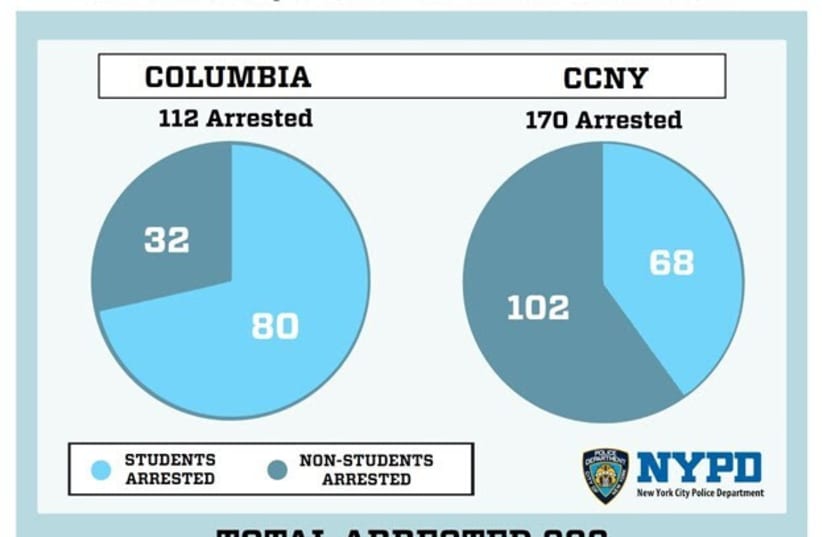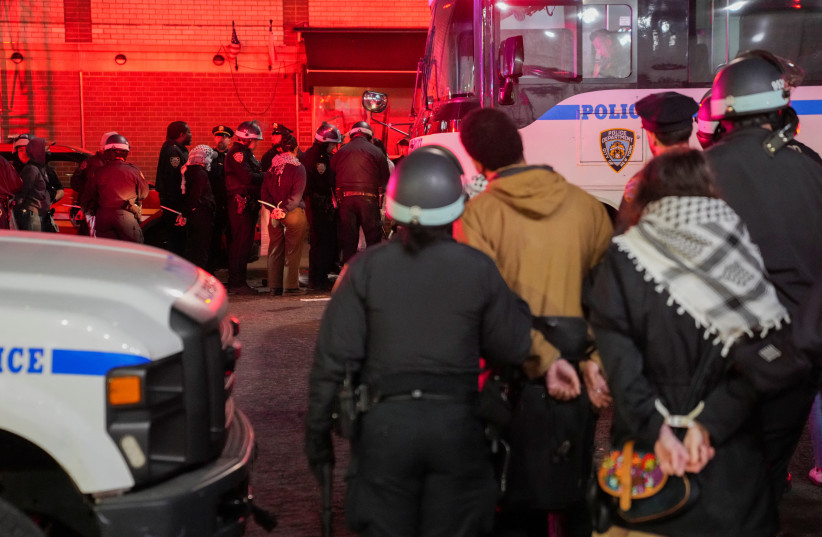Only 68 of the 170 protesters arrested Monday night at City College of New York were students at the school –less than half –_ according to data released over the weekend from the New York Police Department and Mayor Eric Adams’ office.
At Columbia, 32 of the 112 protesters arrested on campus were not students.
In the statement, Adams said it became “abundantly clear” that individuals unaffiliated with the schools had entered the campuses and, in some cases, trained students in unlawful protest tactics.
It’s unclear if those unaffiliated with the schools belong to specific groups.
Nearly half of the protesters on campus were not students
“What is now even clearer is the extent to which outsiders were actually present,” the mayor said. “Nearly half of those arrested at Columbia and City College were not affiliated with these schools. Free speech and peaceful protest remain the fabric of our society, but that is not what we have been witnessing on these campuses.”
It’s clear professional, external actors were trying to escalate the situation, New York Police Department (NYPD) Commissioner Edward Caban said.
“We saw a shift in tactics, and the safety of all students, school faculty, staff, and the public became a real concern,” Caban said. “These once peaceful protests are being exploited by professional outsiders, and our young people are the ones most at risk.”
Columbia University and City College of New York administrators called in the NYPD to clear protests Tuesday night after gathering and being presented with evidence of individuals unaffiliated with the schools influencing violent actions, police said Wednesday morning during a news conference.
According to Caban, there have been more than 2,400 protests and demonstrations across New York City since October 7.
Holding a padlock and thick chain cut from the protesters’ barricade at Columbia, Caban said the NYPD will never be locked out and will always keep their city safe.
While law enforcement was on standby, police emphasized that the call for Tuesday night’s operations came at the last minute.
ADAMS SAID he’d been speaking with Columbia administrators all week. Tuesday night’s request for law enforcement action came after the university acknowledged outside agitators on the ground.
The mayor said police communicated with Columbia and made officials aware of intelligence that there was a real desire for protesters to take over buildings and escalate what was already happening.
In the letter requesting NYPD presence, Columbia itself stated the protest’s escalation was caused by outside agitators, Deputy Commissioner of Operations Kaz Daughtry said.
“At their request, we went in and conducted an operation to allow Columbia University to remove those who have turned the peaceful protest into a place where antisemitism and anti-Israel attitudes were pervasive,” Adams said.
Recognizing the history of the phrase “outside agitators” and its use during the Civil Rights movement to negate protests, New York City’s second mayor of African descent said there were individuals on Columbia’s campus who should not have been there.
Adams said these external actors have a history of escalating situations by trying to create chaos as opposed to peacefully protesting.
The mayor says students breaking into the building were led by outsiders.
While students did break into Hamilton Hall, he said they were led by individuals not related to the university.
Adams described this as a “movement to radicalize young people” and a global problem with young people being influenced by “those who are professional at radicalizing our children.”
Rebecca Weiner is the Deputy Commissioner for Intelligence and Counterterrorism for the NYPD and is also an adjunct associate professor at Columbia’s School for International Public Affairs.
According to Weiner, a number of individuals known for protesting in New York and across the country who are linked to protest training were associated with campus protests.
Weiner noted that the shift in NYPD’s involvement was not about suppressing student ideas but about recognizing the change of tactics used by the protesters, such as wearing all black, breaking doors and windows, barricading themselves, and using makeshift weapons.
Throughout the encampment, police found leaflets detailing where to protest and symbols associated with chaos and disruption.
Weiner said police have seen a nominalization on college campuses of rhetoric – both in language and protest tactics – associated with terrorism.
“That change in tactics, combined with the presence of known individuals on campus to the lead up to what happened in Hamilton Hall, is why there was a real public safety concern,” Weiner said.
While Weiner said there’s concern about radicalization, she wouldn’t describe it as a new breed of homegrown terrorism.
Adams said the city must find a peaceful middle of allowing young people to protest without violence and find the balance of keeping schools, students and the city safe.
Police showed a video of NYPD footage to indicate the majority of the arrests were peaceful. However, there’s heavy criticism from media who were barred from campus during the arrests and said their reporting indicated more violent arrests than police are saying.
Columbia officials have asked the NYPD to maintain a presence on campus until May 17.

